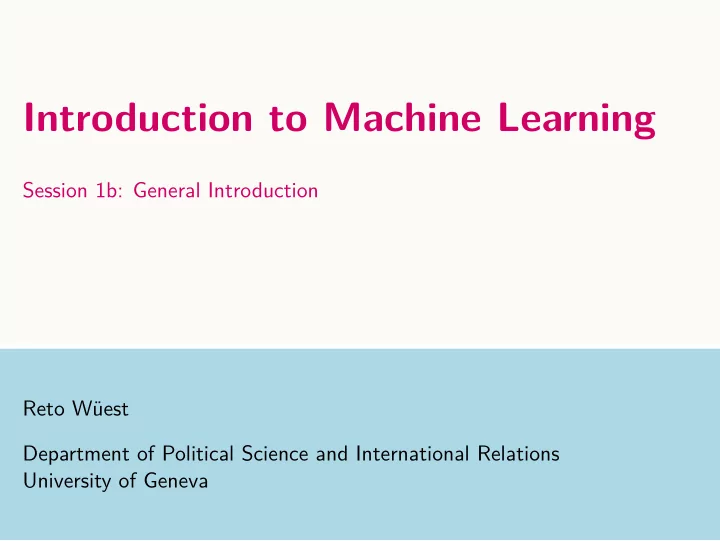

Introduction to Machine Learning Session 1b: General Introduction Reto Wüest Department of Political Science and International Relations University of Geneva
Outline 1 What is Machine Learning? Definition of Machine Learning When Do We Need Machine Learning? Supervised Versus Unsupervised Learning 2 Supervised Learning Fundamental Problem How Do We Estimate f ? Example: f Estimated by Methods with Different Flexibility 1/11
What is Machine Learning? 2/11
Machine Learning Learning The process of converting experience into expertise or knowledge. Machine Learning Machine learning is automated learning. We program computers so that they can learn and improve based on input available to them. • The input to a learning algorithm is training data, representing experience. • The output of a learning algorithm is expertise, which we then use to perform some task. • A successful learning algorithm should be able to progress from individual examples to broader generalization. (Shalev-Shwartz and Ben-David 2014, 19f.) 3/11
When Do We Need Machine Learning? When do we rely on machine learning rather than directly programing computers to carry out the task at hand? • Complex tasks: Tasks that we do not understand well enough to extract a well-defined program from our expertise (e.g., analysis of large and complex data, driving). • Tasks that change over time: Machine learning tools are, by nature, adaptive to the changes in the environment they interact with (e.g., spam detection, speech recognition). 4/11
Supervised Versus Unsupervised Learning Supervised Learning • Data: for every observation i = 1 , . . . , n , we observe a vector of inputs x i and a response y i . • Goal: fit a model that relates response y i to x i in order to accurately predict the response for future observations. • If Y is quantitative, then this problem is a regression problem; if Y is categorical, then it is a classification problem. Unsupervised Learning • Data: for every observation i = 1 , . . . , n , we observe a vector of inputs x i but no associated response y i . • Goal: learning about relationships between the inputs or between the observations. 5/11
Supervised Learning 6/11
Fundamental Problem Suppose Y = f ( X ) + ε , where X ⊥ ⊥ ε and E [ ε ] = 0 . Goal is to estimate f based on observed data ( X, Y ) . 80 80 70 70 60 60 Income Income 50 50 40 40 30 30 20 20 10 12 14 16 18 20 22 10 12 14 16 18 20 22 Years of Education Years of Education (Source: James et al. 2013, 17) 7/11
Fundamental Problem • Given estimate ˆ Y = ˆ f and inputs X , we can predict ˆ f ( X ) . • How accurate is ˆ Y as a prediction for Y ? • For fixed ˆ f and X , �� � 2 � � Y ) 2 � ( Y − ˆ f ( X ) + ε − ˆ = E f ( X ) E � � 2 � � f ( X ) − ˆ = f ( X ) + V ar (1) ε � �� � � �� � reducible irreducible • Our goal is to estimate f so as to minimize the reducible error. 8/11
How Do We Estimate f ? • Our goal is to apply a machine learning method to training data in order to estimate the unknown f . • Training data consist of { ( x i , y i ) } i =1 ,...,n , where x i = ( x i 1 , x i 2 , . . . , x ip ) T . • There are a range of methods for estimating f , some more and some less flexible with regard to the functional form of f . • Flexible methods can fit a wider range of possible functional forms for f , but this comes at the cost of a greater potential for overfitting. 9/11
Example: f Estimated by Methods with Different Flexibility True Model I n c o m e y t i r o i Years of Education n e S (Source: James et al. 2013, 18) 10/11
Example: f Estimated by Methods with Different Flexibility Linear model fit by least squares Income y t i r o Years of Education n i e S Smooth thin-plate spline Rough thin-plate spline I Income n c o m e Seniority y t r i o i Y Years of Education n e e a r s S o f E d u c a t i o n (Source: James et al. 2013, 22ff.) 11/11
Recommend
More recommend